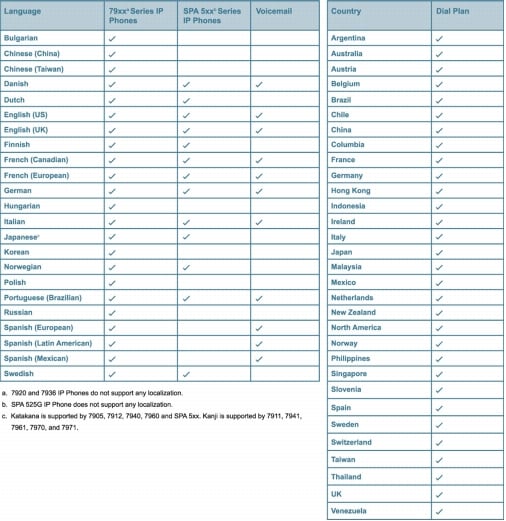Unified Communications 500 Pro Series
สนใจติดต่อ คุณจินดาภรณ์ รอดนวล : 081-137-8777
รหัสสินค้า: UC540W-FXO-K9
- UC System with 4FXO, 1VIC Exp
- Warranty 1 Year
The Cisco® Unified Communications 540 (Figure 1) part of the Cisco Unified Communications 500 Series for Small Business, is a critical part of the Cisco Smart Business Communications System. It is an affordable unified communications appliance that provides voice, data, voicemail, automated attendant, video, security, and wireless capabilities while integrating with existing desktop applications such as calendar, email, and customer relationship management (CRM) programs. This easy-to-manage platform supports up to 32 phones and voice mailboxes and provides flexible deployment options based on your needs, including support for a wide array of IP phones, public switched telephone network (PSTN) interfaces, and Internet connectivity. This reference guide describes the specifications and capabilities of the Cisco Unified Communications 540 (UC 540).
Figure 1. Cisco Unified Communications 540 Models: FXO (Left) and BRI (Right) Product

Product Part Numbers
The Cisco UC 540 is available in two versions, an FXO (analog) model and a Basic Rate Interface (BRI) base model. With ease of ordering as a focus area, each has its own product ID. In addition, there is one software licensing product, multiples of which can be installed to achieve the desired user count. Table 1 lists the part numbers for the Cisco UC 540.
Table 1. Product Part Numbers for the Cisco UC 540
Interfaces and Modules
The Cisco UC 540 has built-in interfaces that offer fixed configurations, reducing complexity. In addition, this platform offers one (1) voice interface card (VIC) slot to support additional Cisco VIC modules. Table 2 lists the built-in interfaces, and Table 3 lists the modular interfaces supported on the UC 540.
Table 2. Built-In Interfaces Supported on the Cisco UC 540
Table 3. Modular VIC Cards for the Cisco UC 540
Licensing
The Cisco UC 540 includes 24 user licenses. These licenses enable the use of Cisco Unified IP Phones and allow users to access the IP PBX features, including voicemail. In addition, supplementary user licenses are bundled to help with deployments that need a few extra licenses. For additional licensing needs, the L-UC-PRO-8U= may be ordered. This increases the existing license count by eight. Table 5 lists the number of users supported based on the hardware/license configurations. The UC 540 also has built-in licenses for unified communications features. Table 4 lists the license count bundled within the system for each feature. Guidance for licenses associated with voice messaging on the UC 540 is included in Table 6.
Note: Among the 24 base licenses provided 16 of them are provided as supplemental licenses.
Table 4. Licensing and User Capacity for the Cisco UC 540
Table 5. Feature Licensing for the Cisco UC 540
* Includes IP security (IPSec), Secure Sockets Layer (SSL), or generic routing encapsulation (GRE) tunnels.
Table 6. Voice Messaging Licensing for the Cisco UC 540
Configuration
|
Voice Messaging Licenses
|
24-user system
|
65 mailboxes*
|
32-user system
|
65 mailboxes*
|
Sessions to voicemail and automated attendant
|
6
|
Internet Message Access Protocol (IMAP) sessions
|
20**
|
* 32 hours of voicemail storage is available by default across all user configurations. Any combination of personal mailboxes and general delivery mailboxes can be used.
** There are 20 simultaneous sessions available between IMAP Client and IMAP server. If all 20 sessions are used up, the remaining session requests will be rejected by the IMAP server. IMAP clients will automatically attempt to establish session with the server once some of the server ports are freed up. This does not limit the number of IMAP clients to 20.
Basic Call Center Capabilities
The Cisco UC 540 supports basic automatic call distribution (BACD) that can help answer outside calls with greetings and menus and allow callers to select the appropriate departments. BACD also provides managed call queues for calls that are waiting to be answered. Table 7 lists the BACD capabilities of the UC 540.
Table 7. Cisco UC 540 BACD Capabilities
In addition to BACD, the Cisco UC 540 integrates with Cisco Unified Contact Center Express (UCCX). UCCX works with up to a maximum of 12 users (agents and supervisor combined) on the UC 540.
Voice Resource Utilization
The Cisco UC 540 includes four digital signal processors (DSPs) that enable digitized voice processing on the platform. The DSP resources available on the platform are used for various unified communications features, namely support of analog and digital VICs, prescheduled or ad hoc voice conference calls, and translation of digitized voice from a less complex codec (such as g711) to a more complex codec (such as g729) - typically used for deployments that use IP trunking (SIP or H.323) for PSTN access or multisite interconnection.
Each DSP can support 16 g711 channels or 8 g729 channels. This enables a total of 64 g711 channels on the Cisco UC 540. Table 8 indicates the DSP resource utilization based on the feature. Tables 9 and 10 show a few deployment scenarios based on the combination of these features.
Table 8. DSP Resource Utilization on the Cisco UC 540
* Total DSP resources will depend upon the number of channels provisioned in the T1.
** Conferencing always uses up an entire DSP. The rest of the features can share a DSP. The number of sessions available will vary depending upon the codec used in a conference call.
Tables 9 and 10 list maximum sessions for either ad hoc conferencing or meet-me conferencing. DSP resources allocated for conferencing can be shared by both features, and a mix of these can be configured. Below are a few examples based on Table 9. The concept of sharing conferencing resources applies to Table 10 as well.
Ad hoc 24x8 Meet-me 0x0
Ad hoc 12x8 Meet-me 12x8
Ad hoc 24x4 Meet-me 6x16
The above examples indicate Sessions x participant.
The Transcoding column lists the maximum transcoding sessions that the system can be configured for, for a given configuration of DSP. For example, the first row in Table 9 indicates that a maximum of three transcoding sessions are available if three DSPs are allocated for conferencing.
If more transcoding sessions are required, DSP resources will need to be diverted from conferencing to transcoding. For example, in the second row of Table 9, one of the DSPs is dedicated to transcoding, leaving two DSPs for conferencing. Notice the increase in the number of transcoding sessions and the drop in the number of conferencing sessions.
Cisco UC 500 series is enabled with localization for IP Phones, Voicemail and Dial Plan. Table 11 summarizes the localization support on the platform.
Table 11. Localization support on UC 500 Series

Hardware Specifications
The hardware specifications for the Cisco UC 540 include physical specifications, environmental specifications, power specifications, and regulatory compliance. Table 12 lists the physical specifications. Table 13 lists the power requirements for the platform. Table 14 provides the environmental specifications, and Table 15 shows the compliance information.
Table 12. Physical Specifications for the Cisco UC 540
Feature
|
Description
|
Packaging type
|
Desktop form factor (1.5 Rack unit high)
|
Console port (up to 115.2 kbps)
|
1
|
Auxiliary port*
|
1
|
* The auxiliary port on the Cisco UC 540 is the same as the console port. The port has an ability to auto-detect modem tones and switch over to the auxiliary port functionality.
Table 13. Power Specifications for the Cisco UC 540
Table 14. Environmental Specifications for the Cisco UC 540
Table 15. Regulatory Compliance for the Cisco UC 540




















0 ความคิดเห็น:
แสดงความคิดเห็น